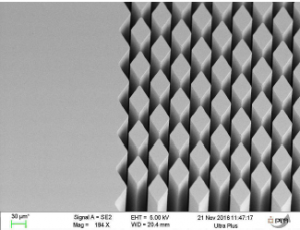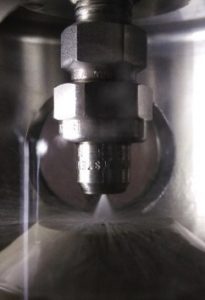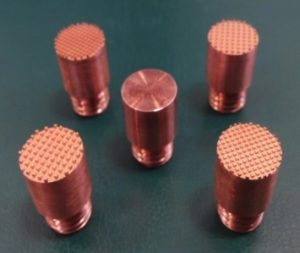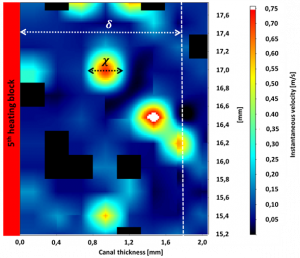This axis presents a great diversity of local (CEA, LRP, G2elab, Simap) and national (Cethils, IMFT, IUST, Pprime) subjects and collaborations. A privileged partnership exists with CEA Grenoble, which hosts two of our members in the Liten. The industrial partners concerned by the issue of heat transfer are Alcatel, PSA, Thalles, Safran. All the teacher-researchers of the 62nd section of the CNU participate in this research. For the period under review, eight theses have been defended and three others are in progress.
Many processes require effective temperature control and high heat exchange at the interface of a wall and a fluid. The intensification of heat transfers by forced convection in single-phase or two-phase mode is a permanent research focus of the Energy team. The historic partnership with CEA Grenoble (which welcomes two members of the team to the Liten) has been enhanced by a new collaboration with INAC’s Low Temperature Department. We also have a recurring collaboration with the G2Elab on the topic of cooling power electronics.
The intensification of transfers is addressed by two methods.
One method that can be described as passive is to structure the surface of the wall of a regenerator or exchanger. This structuring can be done in different forms and at different scales. The presence on the Grenoble site of micro nanofabrication plants (PTA at the CEA, Nanofab at the CNRS) is a valuable asset that contributes to the dynamism and originality of this research.
We have developed a microstructured surface for the optimization of the miniaturization of cryoregenerators of the pulsed gas tube type, used in the space industry (CEA INAC SBT). These circuits operate with a single-phase gas flow. The means of microfabrication have enabled us to integrate different networks with perfectly controlled geometry into microchannels, and to study the influence of appearance and porosity factors on both the pressure drop of the flowing gas and on heat exchanges (A. Sochinskii, Labex LANEF CEA SBT). Reducing the porosity of the network improves heat exchange but increases pressure drops and the difficulty is to reach a favourable energy compromise. The simulation study of heat flow and transfer under stationary conditions showed that such geometries were indeed more efficient than those of conventional regenerators composed of a cluster of spheres or metal fibres. The experimental flow study confirmed and quantified the influence of porosity on the associated pressure losses.

In some situations, a single-phase flow is insufficient to ensure the evacuation of the heat flow. Several methods of two-phase cooling exist: nucleated boiling (a hot surface is immersed in a fluid), convective boiling (a fluid flows in a hot channel) and spray cooling (a droplet fluid impacts a hot surface) the latter technique being able to evacuate up to 1000 W/cm2 because it combines liquid convection and drop evaporation.

A simple surface structure can play a role in boiling: a hydrophobic surface will promote nucleation, while a hydrophilic surface will facilitate the detachment of vapour bubbles. We have studied thermosensitive polymer coatings that exhibit a sudden change in surface energy as a function of temperature: hydrophilic below a critical temperature, they become hydrophobic above. The idea is to control the boiling at this critical temperature, so that the formation of steam is done in a hydrophobic condition and the enthalpy drawn from the wall during boiling cools it down below in order to facilitate the detachment of the bubbles[Bertossi et al. 2015].


A more refined surface structure increases the number of nucleation sites and the theoretical frequency of bubble emission, which should improve heat exchange. Concerning the optimization of an exchanger wall, we found that surface structuring will not be done on the same scale according to the type of cooling method (nucleated boiling, convective, spray). We have shown that a combination of macroscopic and microscopic structuring scales is sometimes necessary (M.C. Riofrio, FUI Thermofluide & Carnot Institute). Spray cooling is influenced by several coupled physical phenomena whose role is reinforced either by macroscopic structuring (critical flow delay, hydrophobicity) or by micro or nanometric structuring (wettability, capillarity, nucleation sites)[Riofrio et al. 2016]. These findings are currently being used to study dielectric fluids that may become two-phase in the event of high heat flows (usable for cooling electric vehicle batteries). The use of a dielectric fluid through porous materials is also considered in order to optimize cooling systems for power electronics (J. Glass, Idex/IRS UGA).
A second method of intensification, which can be described as active, is to apply a magnetic field or an acoustic field to a flow to intensify transfers.
The influence of magnetic induction (intensity, uniformity) on the rheology and thermal conductivity of a ferrofluid has been studied experimentally (W. Cherief). This experimental approach made it possible to highlight the influence of the magnetic field and its intensity on the shear forces. In addition, the study of forced convection heat exchange under magnetic field, with a heat flux condition imposed on the wall, characterized the influence of several parameters related to the spatial configuration of the applied magnetic field, and the effect of field uniformity on the intensification of heat exchange. The understanding and analysis of these results was consolidated by studying the thermal conductivity of ferrofluid under magnetic field. At the end of these characterizations, the application of ferrofluids for cooling power electronic components was tested by an experimental implementation. These tests pave the way for new research and allow reflections on the fields of application of ferrofluids[Cherief et al. 2017].
The application of an ultrasonic acoustic wave perpendicular to the flow direction of a fluid has demonstrated its effectiveness in intensifying heat transfer. Acoustic currents generated at a frequency of 2MHz have a significant influence on the hydrodynamic disturbance of the flow at a macroscopic scale, and this influence is more pronounced in laminar regime where the flow is by definition stable. The heat exchange coefficient at the wall doubles between a’silent’ mode where no field is applied and an acoustic mode, as long as Re < 2000. This gain is reduced in turbulent conditions, but remains higher than the unit[Bulliard – Sauret et al. 2017]. At an excitation frequency of 25 kHz, acoustic cavitation appears and the implosion of vapour bubbles disrupts the hydrodynamics of the flow at a finer scale, in the order of one millimeter. This disturbance has an impact on the thermal boundary layer when the characteristic sizes of the boundary layer and the cavitation influence zone are of the same order of magnitude.

The presence of acoustic cavitation in an exchanger intensifies transfers thanks to the additional level of turbulence caused by the implosion of cavitation bubbles. The long-term objective is to design a new type of heat exchanger – reactor incorporating ultrasonic technology, capable of reducing fouling problems as well. The results obtained have therefore led to a better understanding of the mechanisms of action of ultrasonic waves at the hydrodynamic and thermal boundary layer (O. Bulliard – Sauret, Ademe). The tests carried out followed two distinct but perfectly complementary approaches: a thermal approach allowing access to characteristic heat transfer quantities (local convective exchange coefficients); and a hydrodynamic approach using PIV to establish the link with the turbulence observed within the flow (C. Poncet).
(F. Ayela, N. Caney, D. Colombet, S. Ferrouillat)




